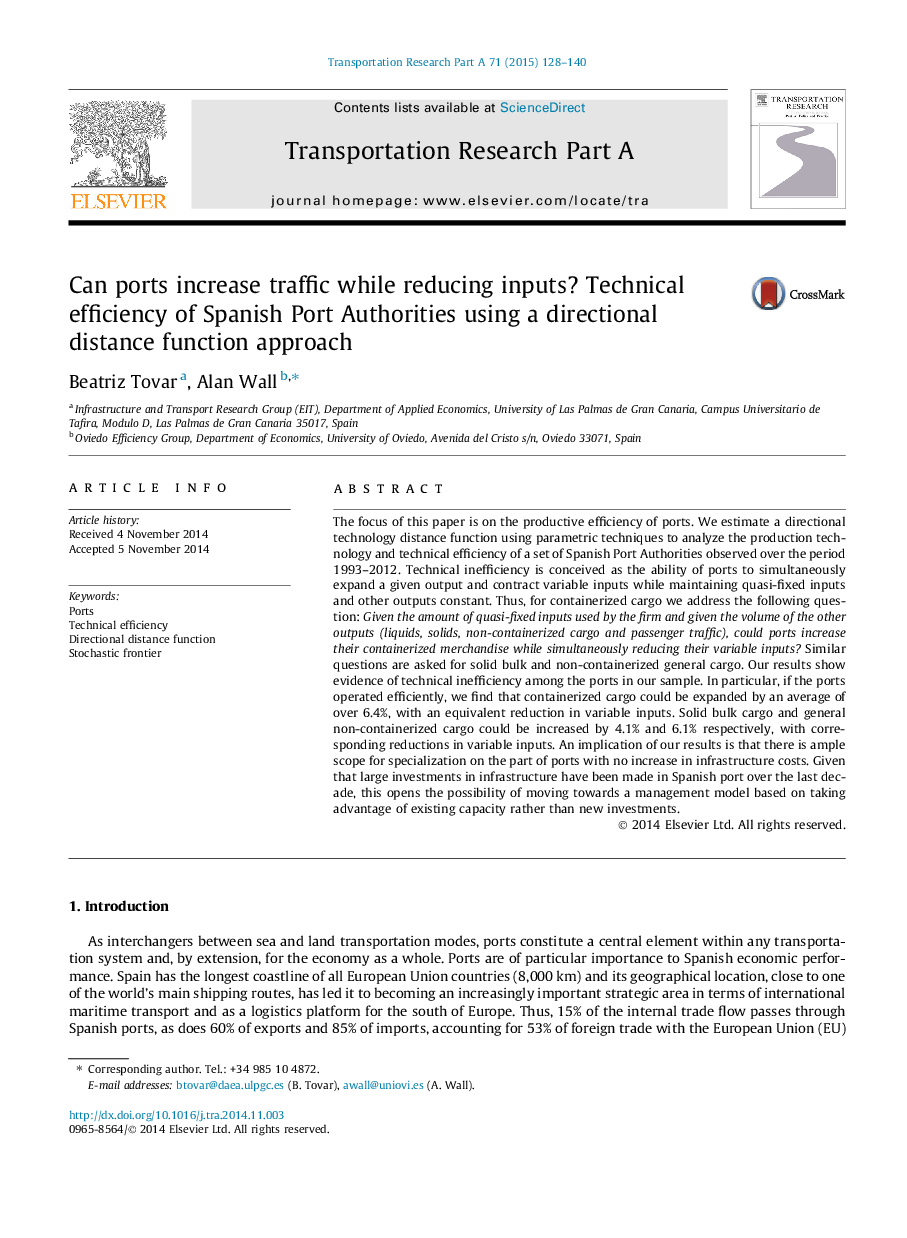| کد مقاله | کد نشریه | سال انتشار | مقاله انگلیسی | نسخه تمام متن |
|---|---|---|---|---|
| 6781383 | 533117 | 2015 | 13 صفحه PDF | دانلود رایگان |
عنوان انگلیسی مقاله ISI
Can ports increase traffic while reducing inputs? Technical efficiency of Spanish Port Authorities using a directional distance function approach
ترجمه فارسی عنوان
آیا بنادر می تواند ترافیک را افزایش دهد در حالی که کاهش ورودی ها؟ بهره وری فنی مقامات پورت اسپانیا با استفاده از رویکرد عملکرد فاصله جهت
دانلود مقاله + سفارش ترجمه
دانلود مقاله ISI انگلیسی
رایگان برای ایرانیان
کلمات کلیدی
بنادر، کارایی فنی، تابع فاصله جهت، مرزی تصادفی
ترجمه چکیده
تمرکز این مقاله بر بازدهی تولید بنادر است. ما تخمین می زنیم که عملکرد ترافیکی فناوری جهت دار با استفاده از تکنیک های پارامتریک برای تحلیل تکنولوژی تولید و کارایی فنی مجموعه ای از مقامات پورت اسپانیا در طول دوره 1993-2012 مشاهده شده است. ناکارآمدی فنی به عنوان توانایی بنادر برای همزمان سازی خروجی داده شده و ورودی های متغیر قراردادی، در حالی که ورودی های نیمه ثابت و خروجی های دیگر ثابت است، در نظر گرفته می شود. بنابراین، برای محموله های کانتینری ما به سوال زیر پاسخ می دهیم: با توجه به مقدار ورودی های نیمه ثابت که توسط شرکت استفاده می شود و با توجه به حجم خروجی های دیگر (مایعات، مواد جامد، محموله های غیر کانتینری و ترافیک مسافری)، می توانند بنادر کانتینر خود را افزایش دهند کالاها را همزمان کاهش می دهد؟ سوالات مشابهی برای محموله های عمومی و غیر کانتینری مورد نیاز است. نتایج ما شواهدی در مورد ناکارآمدی فنی در میان بنادر نمونه ما نشان می دهد. به طور خاص، اگر بنادر به طور موثر عمل می کنند، ما می بینیم که محموله های کانتینری می تواند به طور متوسط بیش از 6.4٪ گسترش یابد، با کاهش معادل در ورودی های متغیر. محموله فله جامد و محموله غیر کانتینری عمومی می تواند به ترتیب 4.1٪ و 6.1٪ افزایش یابد، با کاهش مربوط به ورودی های متغیر. یک نتیجه از نتایج ما این است که دامنه وسیعی برای تخصص در بخشی از بنادر بدون افزایش هزینه های زیربنایی وجود دارد. با توجه به اینکه سرمایه گذاری های بزرگی در زیرساخت ها در دهه گذشته در بندر اسپانیا انجام شده است، این امکان را به سمت یک مدل مدیریت بر اساس استفاده از ظرفیت موجود به جای سرمایه گذاری های جدید باز می کند.
موضوعات مرتبط
مهندسی و علوم پایه
سایر رشته های مهندسی
مهندسی عمران و سازه
چکیده انگلیسی
The focus of this paper is on the productive efficiency of ports. We estimate a directional technology distance function using parametric techniques to analyze the production technology and technical efficiency of a set of Spanish Port Authorities observed over the period 1993-2012. Technical inefficiency is conceived as the ability of ports to simultaneously expand a given output and contract variable inputs while maintaining quasi-fixed inputs and other outputs constant. Thus, for containerized cargo we address the following question: Given the amount of quasi-fixed inputs used by the firm and given the volume of the other outputs (liquids, solids, non-containerized cargo and passenger traffic), could ports increase their containerized merchandise while simultaneously reducing their variable inputs? Similar questions are asked for solid bulk and non-containerized general cargo. Our results show evidence of technical inefficiency among the ports in our sample. In particular, if the ports operated efficiently, we find that containerized cargo could be expanded by an average of over 6.4%, with an equivalent reduction in variable inputs. Solid bulk cargo and general non-containerized cargo could be increased by 4.1% and 6.1% respectively, with corresponding reductions in variable inputs. An implication of our results is that there is ample scope for specialization on the part of ports with no increase in infrastructure costs. Given that large investments in infrastructure have been made in Spanish port over the last decade, this opens the possibility of moving towards a management model based on taking advantage of existing capacity rather than new investments.
ناشر
Database: Elsevier - ScienceDirect (ساینس دایرکت)
Journal: Transportation Research Part A: Policy and Practice - Volume 71, January 2015, Pages 128-140
Journal: Transportation Research Part A: Policy and Practice - Volume 71, January 2015, Pages 128-140
نویسندگان
Beatriz Tovar, Alan Wall,
